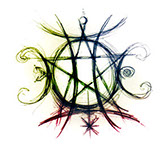

Tracing the Wheel of the Year
Most Witches view time as a wheel, and as we go through the seasons, we are turning the wheel of life. Most modern Pagans celebrate eight Sabbats that act as "spokes" on the frame of the wheel: Imbolc, Ostara (Vernal Equinox), Beltane, Litha (Midsummer, the Summer Solstice), Lughnassadh, Mabon (Autumnal Equinox), Samhain, and Yule (Winter Solstice). These days original from farming festivals (plant, grow, harvest, rest), deity feast days, and cross-quarter days (equinoxes and solstices). In Traditional Witchcraft, each Family may have other very special days that are venerated, and the dates of Sabbats and other days usually fall in accordance to the traditional dating from the country of origin. The ones listed are the most common and popular Sabbatsand their Celtic and/or American names. To learn more about each of these sacred days and suggestions on celebrating them, read on!
Imbolc
Imbolc, Imbolg, or Candlemas means "in the belly" and is usually celebrated on February 2nd. Often rites of initiation and dedication are performed at Imbolc, because the symbolism behind this Sabbat is the idea that something is gestating, forming, waiting to be born. If you are a solitary, this is a good time for a personal dedication ritual---renewing your "vows" if you will. Imbolc is a wonderful time to start spring cleaning---in olden times, all greenery decorating the home from the holidays was taken out and burned, and the house swept through.
The Vernal Equinox, or Ostara
Ostara, or the Spring Equinox is celebrated around March 20th-22nd. (Please note that some traditions celebrate Ostara and the Equinox on different days, depending on their calendar. In our tradition, we celebrate them as one and the same.) The Equinox signifies a time where this a balance between night and day, because on this date they are of equal length
and time. It is also the official beginning of Spring in our hemisphere.If you didn't do a spring cleaning at Imbolc, do it now! I cannot emphasize enough the positive change in energies a clean home makes! If you need a mindset, make a ritual out of it, cleaning and blessing with salt water or herbs as you go along.
Beltane
Beltane occurs on May 1st. The night before is traditionally known as Walpurgis Night. Beltane is opposite on the Wheel from Samhain, and so is known as a day when the veils between the words is the thinnest, or lifted all together. Some consider this day as the return of the Oak King. It is a great time of celebration, and marks a renewal of creative and fertile energy. It is a good day to perform handfastings, witchings, and other rites of passage.
Midsummer
Midsummer is also known as Litha or the Summer Solstice. This is where the sun is visible for the most amount of time then any other day in the year. (Every day afterwards slowly gets shorter.) This is also a good Sabbat for handfastings and rites of passage. It is a time to truly celebrate the fact that all things are in their prime of life at this moment, and to recognize that soon, they will travels towards the doors of Death and Rebirth.
Lammas
Lammas or Lugnassadh (pronounced loo-nassah) is on August 1st. This was traditionally a time when the wheat and other grains were beginning to be harvested for the long winter months ahead. A day of rest is taken, and bread is made with the first grains of the harvest. I would suggest a picnic in the woods with freshmade bread to celebrate this Sabbat.
The Autumnal Equinox, or Mabon
Mabon is also known as the Autumnal Equinox and is the Witches' Thanksgiving. Start to consider the things you have been thankful for over the last year and rejoice in the good things that have come to you. Also consider what hasn't gone your way, and try to examine why. (As with the light, so comes the dark) If you have a group, it's a wonderful time for a potluck ritual and feast! Many traditions also make corn dollies on Mabon to symbolize various things---depending on what they are meant for, they may be burned at Samhain, saved for an entire year, or used in an Imbolc ritual.
Samhain
Samhain, also known as Halloween or All Hallows Eve, is the Witches' New Year. It is properly pronounced "sow-wen." This Sabbat mirrors Beltane, and as mentioned above, is a day when the veils between the worlds are thinnest. From this belief stems the idea that the deceased can be contacted on this night---which explains a lot of Halloween paraphernalia that we see. It is a time to remember those who have passed on, and to reflect on the passing of the year, as well as make plans for the new one. In our tradition, we construct huge labyrinths to walk through, for labyrinths represent the cycle of Birth, Death, and Rebirth. This Sabbat is particularly relevant to the Crone aspect of the Goddess and the Lord of Shadows.
Yule
Yule is the Winter Solstice. This is the darkest, shortest day of the year, and it's pleasant to think that the days will only get longer from Yule onward. In many traditions, this Sabbat represents the birth of Sun God or the return of the Holly King. Traditionally, this is the time when the hearth fires were put out, and then restarted with the Yule Log. If you don't have a fireplace, a candle works very well.